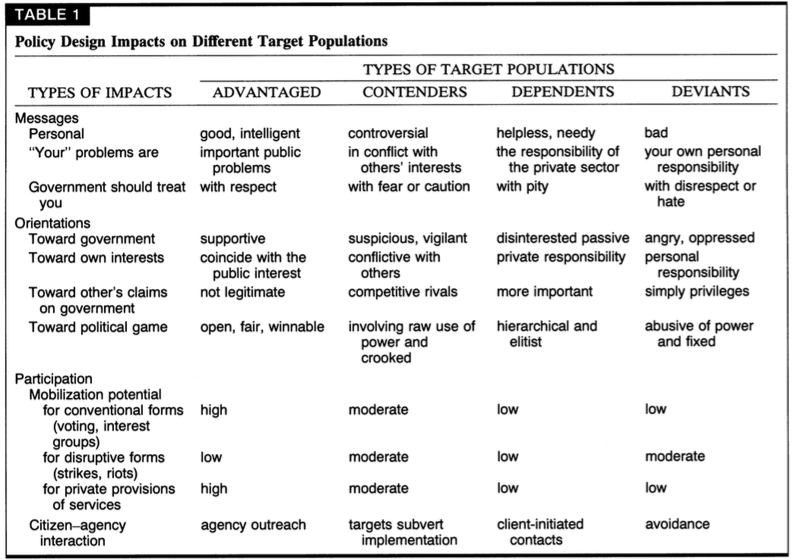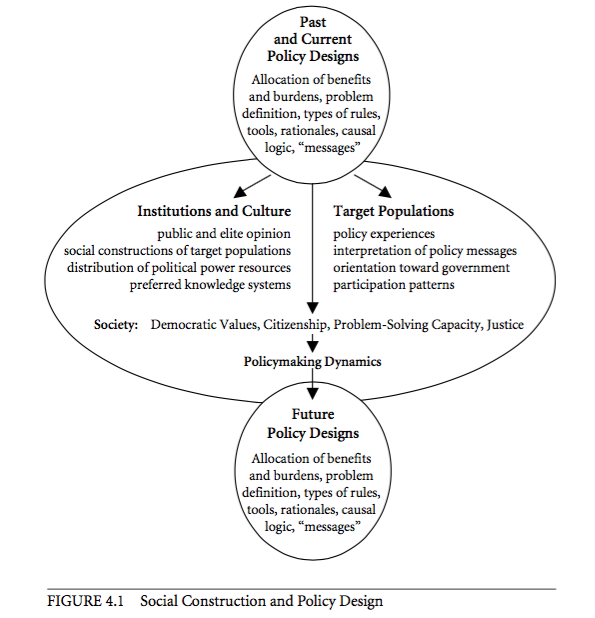Home | Overview | Schedule | Links
EVR 2861
Introduction Environmental Policy
Session Six
Social Construction & Policy Design

Note:
The Ingram et al. (2007) model is based upon the basic assumption of incrementalism as articulated by decision theorist Charles Lindblom (1959) who observed the following:
"It is a matter of common observation that in Western democracies public administrators and policy analysts in general do largely limit their analyses to incremental or marginal differences in policies that are chosen to differ only incrementally. They do not do so, however, solely because they desperately need some way to simplify their problems; they also do so in order to be relevant. Democracies change their policies almost entirely through incremental adjustments. Policy does not move in leaps and bounds." (Lindblom, 1959, p. 84*)
Consequently, Ingram et al. build their policy framework upon policy as it exists currently and historically and then projects how it might be formed in the future given the consideration of a number of current factors).
Reading:
Ingram, Helen; Schneider, Anne L. and Deleon, Peter (2007) "Social Construction and Policy Design," In Paul A. Sabatier's (Ed) Theories of the Policy Process. Cambridge, MA: Westview Press, p. 93-128.
Schneider, Anne L. and Ingram, Helen (1993) "Social Construction of Target Populations: Implications for Politics and Policy," American Political Science Review. Vol. 87, No. 2, p. 334-347.
Pierce, Jonothan J.; Siddika, Saba; Jones, Michael D.; Schumacher, Kristin; Pattison, Andrew and Peterson, Holly (2014) "Social Construction and Policy Design," The Policy Studies Journal. Vol. 42, No. 1, p. 1-29.
Video: Unintended Consequences; China's One-Child Policy
Homework:
- How do policy designs influence the public's participation in solving problems?
- Proposition 1 of the social construction framework states that: "Policy designs structure opportunities and send varying messages to differently constructed target groups about how government behaves and how they are likely to be treated by government. Both the opportunity structures and the messages impact the political orientations and participation patterns of target populations" (Ingram et al., 2007, p. 98). How does this proposition relate to the legal expectation in the U.S. that all people are to be treated equally before the law?
- Proposition 2 of the social construction framework states that: "The allocation of benefits and burdens to target groups in public policy depends upon their extent of political power and their positive or negative social construction on the deserving or undeserving axis" (Ingram et al., 2007, p. 101). How does this proposition relate to the interests of "advantaged" groups versus "contenders" and "dependents" versus "deviants" (Schneider & Ingram, 1993)?
- What does the authors mean when they say "social construction"?
- Proposition 3 of the social construction framework states that: "Policy design elements, including tools, rules, rationales, and delivery structures, differ according to the social construction and power of target groups" (Ingram et al., 2007, p. 104). How does this relate to the manner in which policy initiatives are administered?
- Proposition 5 of the social construction framework states that: "Social constructions of target groups can change, and public policy design is an important, though certainly not singular, force for change. The seeds for altering social constructions can often be found in the unanticipated or unin- tended consequences of previous policy designs" (Ingram et al., 2007, p. 108). Describe what unintended consequences are and how they have been produced by China's effort at population control - the so-called "one-child policy."
- Explain and interpret how the following schematic of a social construction policy design functions.
*Lindblom, Charles (1959) "The Science of Muddling Through," Public Administration Review. Vol. 19, No. 2 (Spring), p. 79-89.

